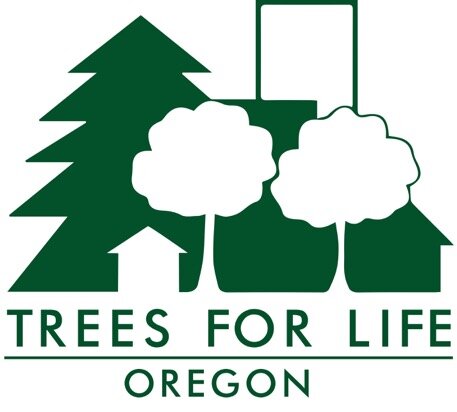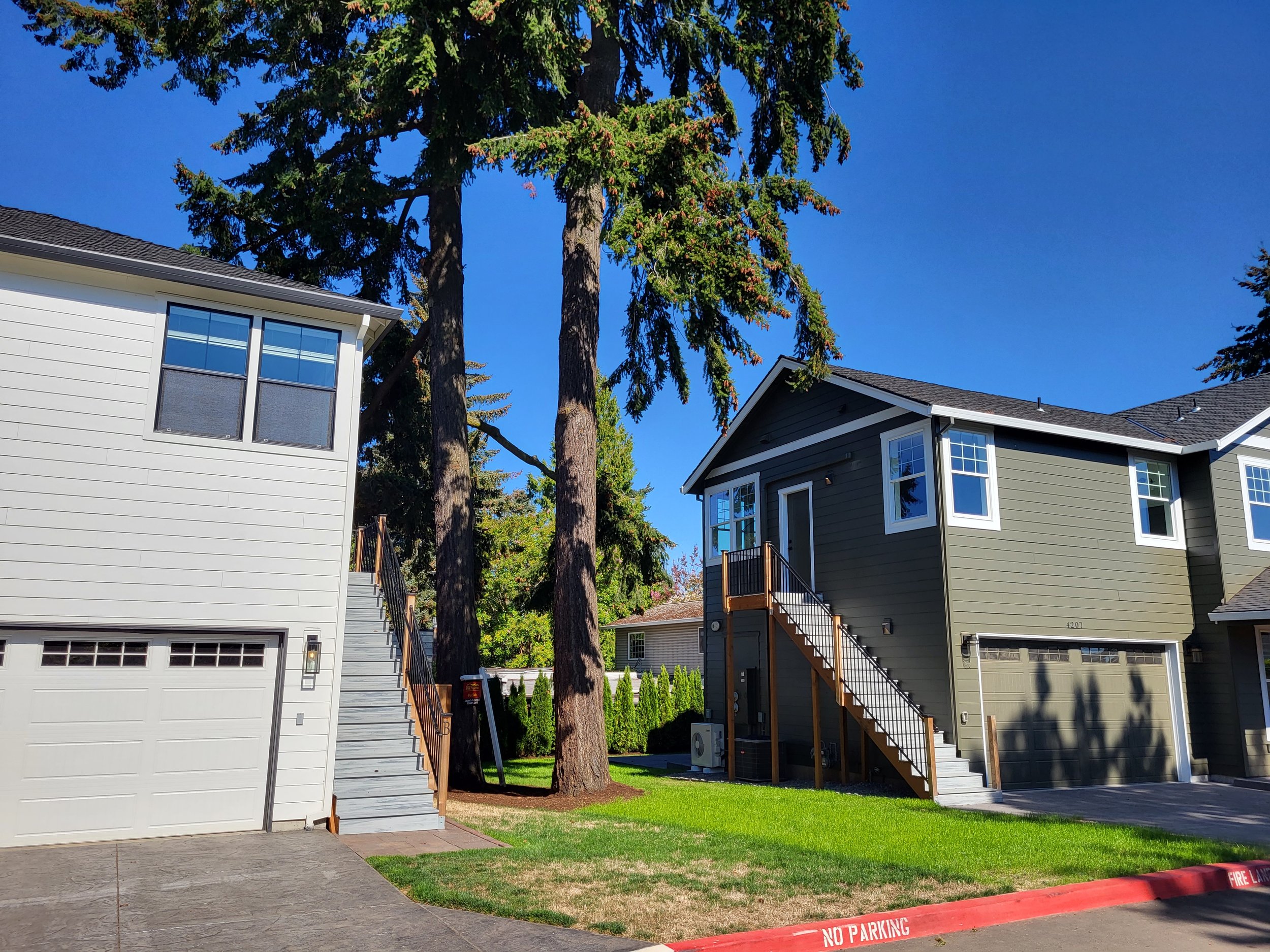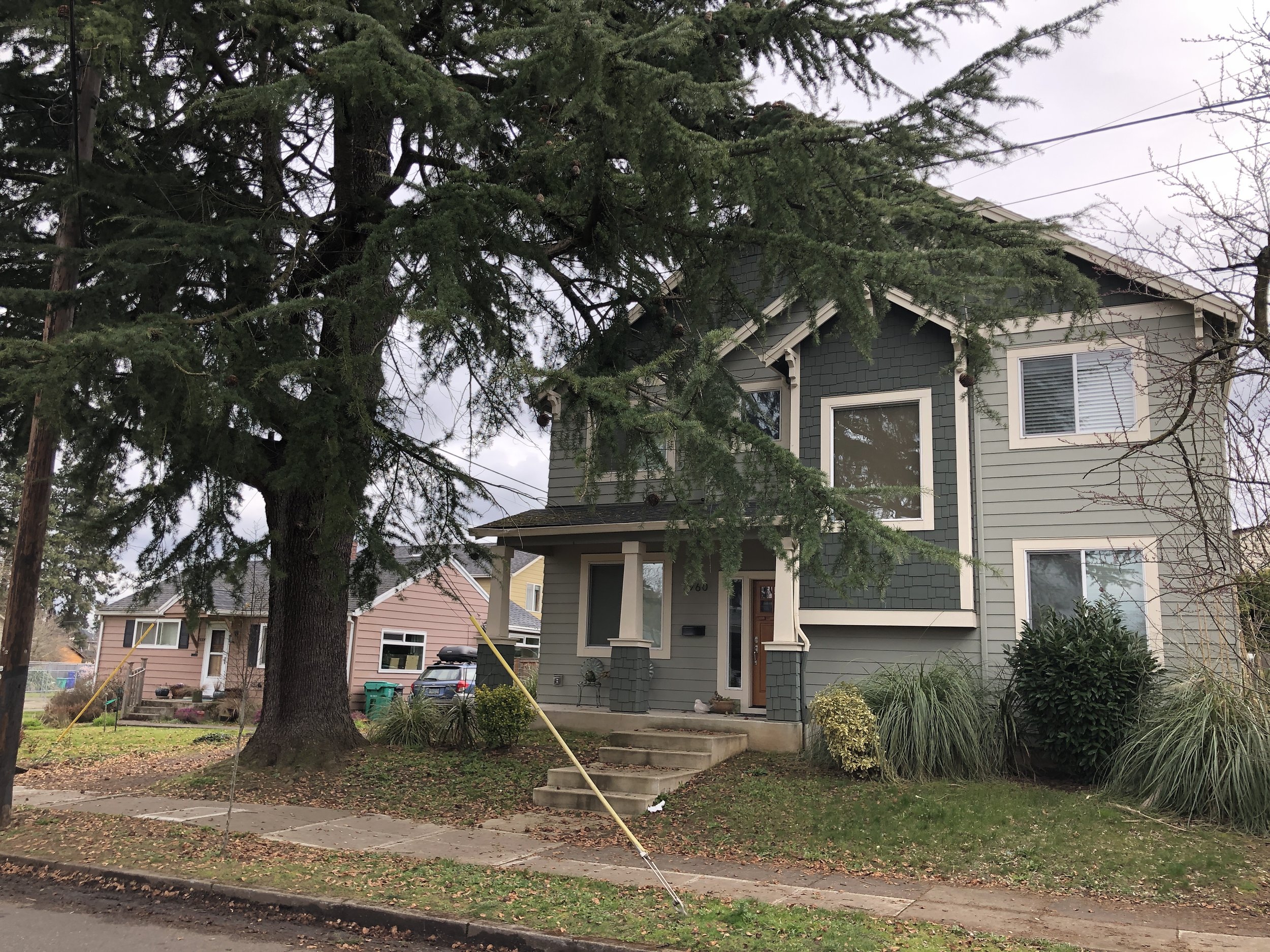A relatively newly built home in Irvington is blessed with a wide planting strip without overhead wires. Its owners were forward-thinking by planting two incense cedars in this roomy spot. Incense cedars are hardy, drought-tolerant, climate-resilient trees that, if properly watered and maintained, especially for their first three to five years, will provide years of large-tree shade and other ecological benefits.
The fence around this large red oak indicates that the developer has chosen to preserve and protect this tree during construction. The residents of this new multi-unit at SE Boise and 52nd will gain health benefits from its being spared removal. The oak will shade them from the scorching summer southern sun, clean ambient air, mute traffic noise, and provide on-site stormwater management for many years to come—a win-win for all.
High-density housing can be made healthier for residents if just a little thought is given for where large or medium-form trees can be located close by. Here, the developer set back the upper floors of this building between NE Weidler and Broadway to give the street trees more light and room to reach their mature form. The Hungarian oak (Quercus frainetto) is a climate-resilient tree that has done well in recent heat waves. Giving it a bit of space will pay dividends for the building's residents in terms of better health and quality of life, especially by mitigating extreme heat.
Preserving this large silver maple was a priority for the individuals who years ago hired Seattle-based architect Grace Kim of Schemata Workshop to design around this shade-giver for the Daybreak Cohousing building they developed to live in. The cohousing founders agreed to sacrifice space for a parking lot in order to save this tree, which they made Daybreak’s logo. One founder-resident, Ken Cameron-Bell, says that Daybreak pays for an arborist to care for the tree twice a year. “It’s expensive but we all want to do it because it’s our tree.”
This huge Garry oak on NE 47th Avenue was preserved when developer Eli Spevak built Cully Green, a cluster of homes off Going Street. The builder had to apply for a variance to move the sidewalk farther from the tree. Variances cost developers time and money. Rather than charge them for doing the right thing by preserving large, environmentally important trees like this one, why can’t the City require builders to tweak sidewalks for this purpose?
This mature red oak is providing maximum environmental benefits at this stage in its life, despite growing in a strip now deemed too narrow for such a large-sized tree. Rather than remove it, the developer of this fourplex at NE 18th and Skidmore worked with the City to save it. The sidewalk was narrowed to give more room to the roots while still meeting ADA standards. Current City code in strips of this size limit selection to short-growing species like dogwoods. But small trees will never provide the shade and other benefits of this large oak. Residents of this new complex will get immediate benefits.
This large, mature oak tree was saved during construction of multiple-family homes in Cully. The effort provided immediate shade and cooling to the new structures, blocking hot afternoon western sun. With enough attention paid to protecting root zones, trees like this one can be incorporated into denser housing options, preserving environmental and social benefits to residents that a newly planted tree might take decades to replace.
This right-of-way planting strip on NE Siskiyou, wide and free of overhead wires, was nonetheless empty for decades until new homeowners planted these tulip trees, whose large form at maturity will shade residents, pedestrians, bicyclists, and cars for many years to come.
Thanks go to the property owner who preserved this pine tree and the space for it to flourish. This one expansive tree provides enough canopy to shade pedestrians and cars across several street and parking lot spaces. The pine provides badly needed relief from scorching summer sun to Portlanders who frequent this southern stretch of NE Broadway near 42nd Avenue. Wouldn't it be great if the City started requiring property owners along commercial streets to follow this example?
Higher density doesn't have to mean losing all yard trees. The developer of these units replaced one home with three new ones, deciding to forfeit a fourth unit to retain these old Douglas-firs between two of the new homes.
Kudos to the developer who preserved this large Western redcedar yard tree when building this home at NE 14th and Failing Street in low-canopy Sabin. Sabin's right-of-way planting strips are narrow, typically only three-feet-wide or less; its small- and medium-size planting strips make up 90 percent of street-tree planting sites. With no space in the right-of-way for large-form trees like this one, this neighborhood is highly dependent on private-property tree preservation and planting to increase its canopy. City street-tree planting requirements in new development can’t compensate for loss of private-property canopy in Sabin.
Preserving this already existing large Atlas cedar was an especially good thing when building this new north Portland home. Its narrow curb planting strip doesn't have room for a tree due to the guywire from the electric pole out of view to the left. Large evergreens provide year-round environmental benefits to people living nearby and to wildlife. A mature tree like this one also provides continuity for long-time neighbors facing redevelopment of their block. The developer also took care to mirror architectural elements of traditional Portland homes.
Redevelopment of this East Portland lot brought a sidewalk and curb, helping define the planting strip and adding to the area’s walkability. Enough space was also left for a large-form tree. The homeowner chose to plant a monkey puzzle tree, native to Chile. These unusual trees help "keep Portland weird."
These new SE homeowners in the Brentwood-Darlington neighborhood have a house where a developer saved a large Douglas-fir in the backyard. Many lots in this neighborhood have large specimens of Oregon's official state tree that are worth saving. How many families in newly built homes will be as lucky as this one to have inherited the shade, air filter, and air conditioning that this tree provides?
This corner-lot Douglas-fir was saved when this SE home in Brentwood-Darlington was built. Hot summer days are undoubtedly much cooler in this house under the shade of this imposing conifer. Will other trees this size be given the room they need when multi-unit buildings are built on lots where they now stand?
It will take years before the deciduous tree planted by this new home’s residents in the Brentwood-Darlington neighborhood gets as big as the ponderosa pine that was saved during construction. Preserving space for this pine still allowed room for a driveway and a single-family home.
This "skinny house" in Rose City Park takes up most of its lot space. But the builder left just enough room for this mature conifer and its root zone. Sparing healthy specimens like this one preserves environmental benefits that might take a replacement tree half a century to achieve.
It's not clear what role if any the city's higher fees for removing 20-inch-diameter or larger trees is having on saving some large-form trees. But whatever the motivation, the developer of this multi-unit building going up on NE 42nd near Fernhill Park in the Cully neighborhood spared this big Douglas-fir. With a protected root zone, this native conifer will continue to provide environmental benefits for area residents new and old. This tree could still be storing carbon, offering shade and habitat, and cleaning the air at the turn of the next century and beyond, since Douglas-firs have a natural lifespan of many centuries.
Most skinny houses leave no room for trees on their small lots. This one in Arbor Lodge is typical in not having room for a tree in the front, but it stands out for having preserved a large Douglas-fir in a corner of the backyard.
Generations of people to come will enjoy this mature, large red oak thanks to a careful developer who built a new home while preserving the root zone around this giant. While much of the front yard is now paved, this tree's wide branches will help shade and cool the pavement while shielding the new home from hot afternoon sun. Not every tree can or should be saved, but with minor adjustments it's possible to preserve these valuable assets. This increases the value of the new home and keeps some visual continuity and sense of place for people in the neighborhood.
Careful construction helped this giant sequoia survive to offer shade and beauty. With a lifespan of hundreds of years, this tree could outlive several dwellings on the same lot if shown respect at each redevelopment.
While this relatively new house on a corner doesn't leave much room for a tree of any size, the builder did take care to preserve the street trees, which provide immediate shade and other benefits for the new owners. When many houses in a row are demolished, street trees may be the only link with the past for people living on streets like this one in north Portland.
This new home is lucky to have a planting strip with no overhead wires and wide enough to accommodate a large-form tree. A young Oregon white oak (Quercus garryana) has been appropriately planted here, ensuring that in a few decades this home and the street and block it sits on will benefit from its shade and the food and habitat it provides for dozens of wildlife species. In many fast-densifying Portland neighborhoods the only space remaining for large-form trees is in street right-of-ways. This makes it even more important to reserve big planting spaces along streets for large trees rather than smaller trees such as dogwoods and Japanese snowbells.
























